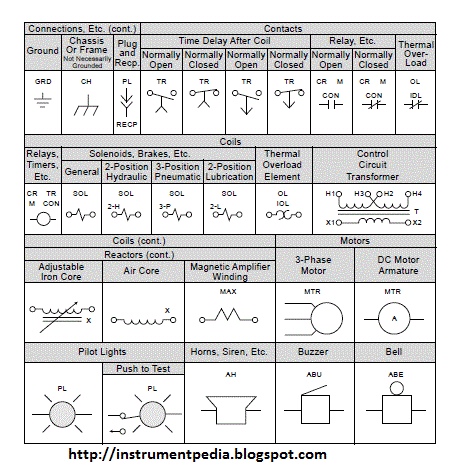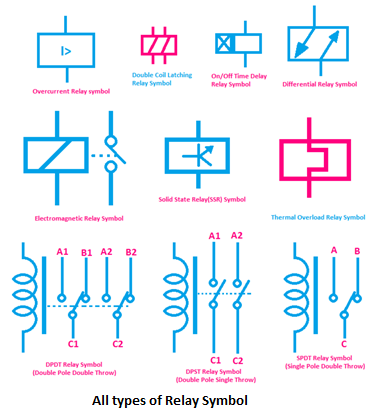Decoding the Mystery of Relay Symbols

Ever stared at a wiring diagram and felt like you were deciphering hieroglyphics? Chances are you stumbled upon a relay symbol and wondered, "What in the world is that?" Well, you're not alone. These cryptic little icons can seem intimidating, but understanding them is crucial for anyone working with electrical circuits.
Relay symbols represent an electromechanical switch that uses a small control current to switch a much larger load current. Think of it like a tiny switch controlling a massive gate. This seemingly simple mechanism plays a vital role in countless applications, from controlling industrial machinery to managing the lights in your home.
So, what exactly does a relay symbol look like? It varies slightly depending on the specific type of relay and the diagramming standard used. However, they generally consist of a coil and a set of contacts. The coil represents the electromagnet, and the contacts depict the switching mechanism. Identifying the different contact arrangements is key to interpreting the relay’s function within the circuit.
Understanding the function of a relay symbol is like unlocking a secret language of electrical control. These symbols simplify complex circuit diagrams, allowing engineers and technicians to quickly grasp the flow of power and the intended operation of the system. Imagine trying to trace the wiring of a complex machine without these symbolic shortcuts – it would be a chaotic mess!
Delving into the history of relay symbols reveals their evolution alongside the development of electrical engineering itself. Early diagrams often used elaborate depictions of the physical relay structure. Over time, these evolved into the standardized symbols we use today, streamlining the design and interpretation of electrical systems.
Relay symbols are fundamental in electrical engineering. They bridge the gap between abstract circuit designs and the physical components they represent. This clear communication is essential for troubleshooting, maintenance, and designing new electrical systems.
A common challenge is differentiating between normally open (NO) and normally closed (NC) relay contacts. NO contacts are open when the relay is de-energized and close when energized. Conversely, NC contacts are closed when de-energized and open when energized. Understanding this distinction is vital for correct circuit operation.
Three key benefits of using relay symbols are: simplified circuit diagrams, standardized communication, and easier troubleshooting. Simplified diagrams make it easier to understand the overall circuit function. Standardized symbols ensure clear communication between engineers and technicians. Easier troubleshooting is facilitated by the clear representation of the relay's function within the circuit.
Relay symbol interpretation is straightforward. Identify the coil and the contacts. Determine the contact type (NO or NC). Trace the connections to understand how the relay controls the circuit.
Advantages and Disadvantages of Using Relays
| Advantages | Disadvantages |
|---|---|
| Electrical Isolation | Slower Switching Speed |
| Low Control Current | Mechanical Wear |
| Multiple Contact Arrangements | Larger Size |
Five best practices for using relay symbols include adhering to standard conventions, clearly labeling contacts, indicating coil voltage, providing a clear diagram key, and using consistent symbol representation.
Five real-world examples of relay usage are: automotive starter systems, industrial control panels, HVAC systems, home automation systems, and telecommunications equipment.
Five challenges and solutions related to relays are: contact bounce (use debouncing circuits), contact arcing (use arc suppression techniques), relay chatter (ensure proper voltage and current), temperature sensitivity (select relays with appropriate temperature ratings), and relay lifespan (regular maintenance and replacement).
FAQs: What is a relay? What is a relay symbol? What are NO and NC contacts? How do relays work? What are the applications of relays? How to choose the right relay? How to test a relay? What are the different types of relays?
Tips and tricks for using relay symbols: always refer to the diagram key, double-check contact types, ensure proper coil voltage, use simulation software to verify circuit operation, and consult with experienced engineers if needed.
In conclusion, understanding relay symbols is essential for anyone working with electrical circuits. These symbols provide a concise and standardized way to represent complex switching mechanisms. From simplifying circuit diagrams to facilitating troubleshooting, the use of relay symbols is crucial for effective design, maintenance, and operation of electrical systems. By mastering the language of these symbols, you can unlock the power and versatility of relays, opening doors to a wide range of electrical control applications. Whether you're a seasoned engineer or a budding hobbyist, understanding relay symbols empowers you to navigate the intricate world of electrical circuits with confidence and precision. Embrace the challenge, and you'll discover that relay symbols are not cryptic hieroglyphics, but rather powerful tools for electrical control.
Unlock your brainpower dot grid journals
Unmasking the dark empath 5 telltale signs
Conquering the california drivers test your ultimate guide













